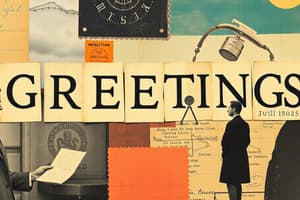Podcast
Questions and Answers
When introducing someone, which phrase correctly uses the grammar presented?
When introducing someone, which phrase correctly uses the grammar presented?
- Tom, this am Carlos.
- Tom, this are Carlos.
- Tom, this be Carlos.
- Tom, this is Carlos. (correct)
In which scenario is it grammatically correct to use 'an' instead of 'a'?
In which scenario is it grammatically correct to use 'an' instead of 'a'?
- A umbrella (correct)
- A bike
- A phone
- A house
If someone asks 'How are you?', which response demonstrates understanding of the grammar and context?
If someone asks 'How are you?', which response demonstrates understanding of the grammar and context?
- I'm Helen.
- Fine, thanks. And you? (correct)
- My name's Usha.
- This Tom.
Which of the following demonstrates the correct pluralization rule as taught in the lesson?
Which of the following demonstrates the correct pluralization rule as taught in the lesson?
To greet someone in the afternoon, which of the following is most appropriate?
To greet someone in the afternoon, which of the following is most appropriate?
Select the option that accurately completes the following introduction: 'Hello, I'm Sarah Taylor. ______.'
Select the option that accurately completes the following introduction: 'Hello, I'm Sarah Taylor. ______.'
Which of these options shows the correct contraction?
Which of these options shows the correct contraction?
What would you say to someone before they go to bed?
What would you say to someone before they go to bed?
If someone says, 'Hello, my name is Elvis Presley', a suitable response could be:
If someone says, 'Hello, my name is Elvis Presley', a suitable response could be:
Given the vocabulary, what is the most suitable question you would ask while pointing to a book?
Given the vocabulary, what is the most suitable question you would ask while pointing to a book?
Flashcards
Salut
Salut
A greeting used to say hello in French.
Konnichiwa
Konnichiwa
A greeting used to say hello in Japanese.
Ciao
Ciao
A greeting used to say hello in Italian.
Ahoj
Ahoj
Signup and view all the flashcards
Hej
Hej
Signup and view all the flashcards
What's your name?
What's your name?
Signup and view all the flashcards
Nice to meet you
Nice to meet you
Signup and view all the flashcards
How are you?
How are you?
Signup and view all the flashcards
Good morning!
Good morning!
Signup and view all the flashcards
Sleep well!
Sleep well!
Signup and view all the flashcards
Study Notes
- This unit focuses on basic greetings, introductions, and everyday English phrases, along with numbers and vocabulary.
- Key grammar points include the use of "am/is/are," possessive adjectives like "my/your," and plural nouns.
Greetings and Introductions
- Common greetings include "Hello," "Hi," and their usage in introductions.
- Using "I’m" followed by a name is a standard way to introduce oneself. For example, "Hello, I'm Mara."
- Questions like "What's your name?" and statements like "My name's Tom" help initiate conversations.
- When introducing someone else, phrases like "Tom, this is Carlos" are used.
- Responding with "Hello" after an introduction is standard protocol.
- The expression "Nice to meet you" is used to convey politeness when meeting someone for the first time.
Grammar: am/is/are
- "I'm" is the contracted form of "I am."
- "What's" is the contracted form of "What is."
- "Name's" is the contracted form of "name is."
How Are You?
- Common responses to "How are you?" include "Fine, thanks. And you?" or "Very well, thank you." with corresponding rejoinders.
Everyday English
- Different times of day call for different greetings: "Good morning!", "Good afternoon!", "Good night!".
- Polite phrases such as "Hello. A cup of tea, please.” are taught.
- "Goodbye!", "Bye! See you later, Mum!" are used for departures.
Vocabulary
- Focus on common English words for everyday objects like "apple," "bus," "phone," "laptop," "umbrella," etc.
- The unit covers asking "What's this in English?" to learn names of objects.
Numbers 1-10 and Plurals
- The numbers from one to ten are introduced: one, two, three, four, five, six, seven, eight, nine, ten.
- Most nouns form plurals by adding "-s" (e.g., "book" becomes "books," "phone" becomes "phones").
- Nouns ending in -s, -sh, -ch, -x, or -z usually add "-es" to form plurals (e.g., "bus" becomes "buses," "sandwich" becomes "sandwiches").
Studying That Suits You
Use AI to generate personalized quizzes and flashcards to suit your learning preferences.




